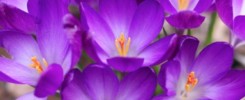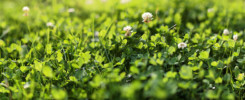English ivy, English holly, periwinkle, lamium, and daphne/spurge laurel are common plants in gardens and disturbed areas throughout the region. However, many people are surprised to learn that these plants are invasive, which means they can harm local ecosystems, human health, and the economy! Invasive plants are non-native plants that can spread rapidly to new areas because predators or diseases from their native homelands are not present to keep them in check.
For example, knotweeds have strong root systems that can grow through concrete and asphalt, damage building foundations, pavement, and bridges, leading to costly repairs. Giant hogweed’s toxic sap can cause severe blistering of skin, scarring and eye damage. English ivy can displace native plants on the forest floor, as well as climb up and smother trees.
Did you know?
In 2016, municipalities in the Metro Vancouver region spent over $1.4 million controlling a half dozen invasive species within parks and other public property. Invasive plants can spread from adjacent private land and some people discard unwanted potted plants in parks without understanding the potential impacts.
How can you help?
Don’t buy invasive plants.
Most invasive plants are spread by human activities and unfortunately, some are still available at your local garden centre or community plant sales. To avoid future headaches, it’s important not to plant them in your garden.
Invasive plants in your backyard?
Here are some tips and tricks to tackle them:
- For knotweeds, giant hogweed, and daphne/spurge laurel – To protect yourself, your family and reduce the risk of further spread, these plants are best controlled by trained professionals who will confirm their identity, remove or treat them while using protective gear, and transport the material safely to an appropriate disposal facility. Note: Due to concerns about worker safety, Metro Vancouver Transfer Stations do not accept giant hogweed or daphne/spurge laurel. These species must be double-bagged and transported directly to the Vancouver landfill.
- For other invasive plants – Most other invasive plants can be removed by hand pulling or digging up the roots. Some spread by seed, so it is best to remove them before they flower. Regular tending for several seasons may be necessary to completely eradicate them from your yard. Please dispose of the leaves, stems and roots in your municipal green waste or garbage bin.
- DO NOT compost invasive plants in your backyard composter – The seeds and roots of these plants will not be destroyed at such low composting temperatures and they will spread throughout your garden if the compost is used.
Replace invasive plants with a Grow Green alternative!
Many similar non-invasive plants are available in the Metro Vancouver region. Here’s some suggestions:
| Invasive Plant | Grow Green Alternative |
|---|---|
| Knotweeds (Japanese, bohemian, giant and Himalayan)
|
|
Giant hogweed
 |
|
| Daphne/Spurge laurel
|
|
| Himalayan blackberry
|
|
Scotch broom
 |
|
English holly
 |
|
| English ivy
|
|
Common periwinkle
 |
|
Lamium/Yellow archangel
 |
|
Butterfly bush
 |
|
For more information about invasive plants:







